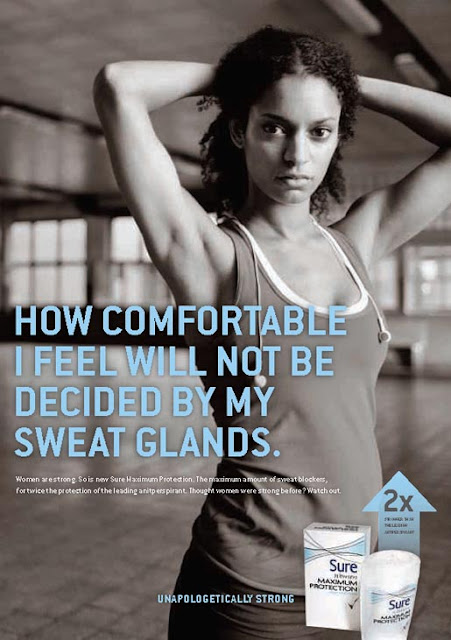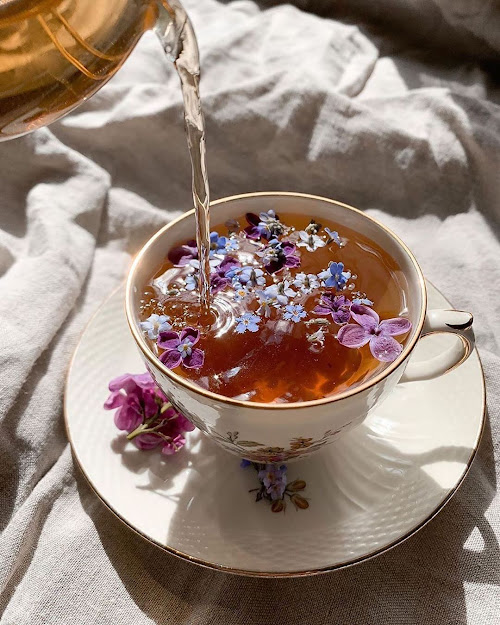Comparison of 2 Multimodal Texts
The advertisements that have been selected for analysis are the Axe (Lynx) Dark Temptation shower gel advertising campaign released in 2011, and the 2011 Sure Maximum Protection deodorant advertising campaign. Interestingly, these texts have been constructed to represent women in polar opposite directions; the male targeting Axe advertisement using women and their sexuality as a way to persuade males to purchase the product, conversely the Sureadvertisement, which targets a female audience, has been constructed with the ideology that women are strong and able to accomplish anything, and through purchasing the product they are able to achieve their full potential as a woman. Both texts are likely to be found on billboards, bus stop and train station advertisements, as well as having produced a moving-image based advertisement which has featured on television. These texts were chosen for analysis as the ideologies and the way which they attempt to persuade the audience are so intrinsically different, and thus provided the opportunity to demonstrate the contrast between male and female advertising ‘communities’, and the representation of genders within these communities.
As the selected texts are both advertisements, Goddard (1998, p.10) suggests that the “intention is to enhance the image of an individual” whom has been represented within the text. Therefore, it can be understood that the “viewers are themselves explicitly represented in the image” (Kress et al, 2006, p.48). Evidently, this concept can be successfully applied to text B, as the represented female participant is promoting positive ideologies about female strength and empowerment which the viewer of the text will thus want themselves. Consequently, the viewer will want to purchase the product to ‘enhance’ their own image. Text A can also be understood to reflect the target audience, as the represented male participant reflects societies average male, as the participant is not particularly muscular and withstands a realistic body expectation for men. It has been suggested by Kress et al(2006, p.115) that producers must submit to the “defined values and beliefs…within which their work is produced and circulated”, arguably so it targets the specific consumer community which their product has been created for. Thus the ‘values and beliefs’ of text A can be understood that if the male consumer uses Axe shower gel, they will seem more attractive to women and ultimately be more successful with women. Goatly (2000, p.136) furtherly supports Kress et al’s claim, explaining that the audience understands information through schemas; “the facilities for storing stereotypical knowledge”. In this case, the ‘stereotypical knowledge’ is that males appeal to women through being attractive in some form, the schema of the text then gives what can be proposed a solution, as males simply need to use the product to complete the schema.
Generally, the texts will need to be cohesive as a whole in order to make sense to the passive participant, as it is understood when “some element in the discourse is dependent on that of another” (Halliday et al, 1976, p.4). This therefore suggests that all frames, vectors and word-image relations within the texts will be cohesive as they depend upon each other to convey the producer’s ideology. Furthermore, this concept is supported by Kress et al (2006, p17) who suggests that texts are “designed as coherent entities by means of layout”, which can be applied to the layout of advertisements. Thus, this means that all text and images found within the advertisements have been constructed so that the give the audience information which allows them to interpret the purpose of the text, and Van Dijk, as cited by Chilton (2009, p.176) similarly suggests “understanding a text means that people are able to construct a mental model for the text”. Therefore, the audience must apply their own knowledge in order to successfully decode texts, and thus interpret their meaning.
Text A, the Axe shower gel, has been constructed with the framing of two images on the left and right, a product tag line central to both images at the bottom of the advertisement, and an image of the product itself between the text. The text appears to have been constructed with a ‘before’ and ‘after’ structure; the before of a man from behind, thus with an offered gaze, covered in lather in a shower, the after as a replicated image; however of a woman in the same stance but holding a whip down her back rather than the shower brush the male participant is holding. Although both represented participants have an offered contact with the audience, it can be suggested the second image of the woman has been composed as a voyeuristic image through symbols such as the whip, where the male target audience gets pleasure from viewing its sensuality. Cohesion within text A is evident through its sequential construction, such as its ‘given’ and ‘new’ sequence. The ‘given’ information on the left can be that fundamentally all males shower as a part of their day-to-day routine, and this male in particular has introduced Axe shower gel as a step of his daily routine. The ‘new’ information therefore is the image of the unclothed woman on the left, seen dragging a whip down her back, which the audience can infer is a result of the male participant smelling and thus seeming attractive to the female participant. The ideology Axeis therefore trying to promote is that women cannot control themselves sexually around any male whom uses this product- the scent is too irresistible. This concept is furthermore enforced through the word-image relation of the juxtaposing tagline “The cleaner you are the dirtier you get” seen in the bottom frame, with the synthetic personalisation of the second person pronoun ‘you’ used to directly appeal to the target audience, and appear as if the text is giving man-to-man advice on spicing up the male audience’s sex life.
The images of the male and female participant’s bodies contrasts against the dark grey backgrounds, and the slight white light that surrounds their bodies furthermore positions them as centre of attention. Interestingly, the image of the product itself is small in comparison, and its black bottle blends into the dark background. Perhaps this technique has been used to make the product seem mysterious as if it is a man’s secret weapon, thus resulting in the reader aspiring to have the product for themselves. The vectors within the two images in text A have been replicated through the male and females gesture codes being identical. Both participants and central within their own frames, with their right arms are stretched up and around in a triangular shape, holding an object down the spine of their back.
Text B, an advertisement for the brand Sure’s new maximum strength deodorant features three major frames, the first being the female participant as shown through a medium shot, a bulk of written text across the middle of text B, and lastly the product image in the bottom third of the text. Collectively, these frames create a sense of cohesion within text B as they giver further information about each other. The audience initially views the female participant; perhaps creating enigmas within the audience, causing them to read the bulk of text which sets the context of the image- the female participant is doing some sort of strenuous exercise. Lastly, any remaining enigmas are answered in the final frame through the image of the product, which the audience will recognise as deodorant through the brand identity. The female participant has been positioned to create a ‘demand’ contact, thus inviting them to engage with the text directly addressing the audience, and collaboratively with the low-angle the represented participant has been constructed as more powerful than the audience. This seemingly follows the multi-modal semantic field of strength and power within women that text B enforces as its ideology, which is made explicit through the tagline ‘Unapologetically Strong’. This conflicts with the ideology that text A attempts to enforce, as text A ultimately presents woman as weak-minded as they find the scent of the product so irresistible, they will do anything to please the male participant. Text B however constructs the ideational meaning that women are strong, and by using this product they no longer have to be held back or uncomfortable- they are able to accomplish anything. Contrastingly, the participant has been positioned at an oblique angle, which creates detachment from the represented participant and passive participant, as if the passive is observing the represented, however the demand address opposes this as it constructs a relationship with the passive participant.
There are multiple vectors constructed within text B such as one created which follows the participants arm on the left of the text downwards in a diagonal line towards the represented participant’s armpit, where another vector meets it horizontally at the base of the armpit. This technique may have been used to draw attention to the participant’s armpit, as it is the area which the product is used, to demonstrate the reliability of the product. The other vector leads from the image of the product up toward the participant’s other armpit, which again proves the reliability of the product, as through her gesture the represented participant is shown to have no reason to be scared to open her arms wide. Unlike text A, text B has been constructed so that the white product stands up brightly against the grey background. It can be suggested the authors of the text did this to make the advertisement straightforward and explicit in what the product is, unlike in text A where the product isn’t the main feature of the advertisement. Perhaps text B does this due to its nature, as the texts target audience simply wants a product which can achieve its one job, and thus the advertisement has been created to reflect the simplicity of the products purpose.
To summarise; the two chosen texts have both been constructed cohesively, so that individual aspects of the texts, such as the image of the participant in text B and the image of the product in text B, can be understood. If one or more of the frames within the texts were not included, the texts purpose would become considerably more implicit, and consequently the product sales may be affected by this. It is also important to recognise the nature of the representations of gender that were found within each text; text A taking a more masculine and male dominating ideology, where the male participant appeals through his scent, overpowering the female participant’s inhibitions and making her lose control. Text B’s representation of women contrasted with text A’s, as women are presented as being strong-minded and powerful, thus possessing what could be suggested as traditionally male attributes. Although text A can be recognised to have a more negative representation of the female participant than text B, it is important to have understood the different target audiences as well as purposes of the actual products themselves; one is to ‘appeal’ (to a potential partner), one is to ‘defend’ (from unwanted perspiration). Thus, text A and B contrast fundamentally due to their different target audiences, and what those target audiences want to gain from the product.



Comments
Post a Comment